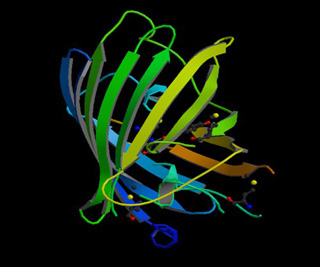
Ribbon diagram of the crystal structure of green fluorescent protein. (Image courtesy of RCSB Protein Data Bank entry 1EMA.)
Instructor(s)
Dr. Mark Howarth
Dr. Anthony Leung
MIT Course Number
7.341
As Taught In
Fall 2006
Level
Undergraduate
Course Description
Course Description
One summer in the 1960s a young Japanese researcher, with the help of a few high school students, chopped up ten thousand jellyfish. As a by-product of this harvest, they isolated a green fluorescent protein (GFP). Since then, GFP has triggered a revolution in our understanding of gene expression and signaling in live cells. In this seminar, we will examine how this small protein generates fluorescence, i.e. absorbs light of one wavelength and emits light of a longer wavelength. We will discuss how the color palette has been extended from green to blue, red and many other colors, based on protein engineering of GFP and the study of vividly colorful coral reefs. We will then investigate how these fluorescent proteins can be used to track the motion of DNA, RNA and protein in living cells, as well as to see waves of signaling molecules propagate across a cell. GFP is also a powerful tool for fluorescent imaging of whole organisms, from worms to mice, and we will see how it has been used in tracking the spread of cancer cells, controlling malaria and in understanding how neuronal connections form. In this seminar, we will explore this wonderful protein as well as other important methods and reagents for fluorescent imaging.
This course is one of many Advanced Undergraduate Seminars offered by the Biology Department at MIT. These seminars are tailored for students with an interest in using primary research literature to discuss and learn about current biological research in a highly interactive setting. Many instructors of the Advanced Undergraduate Seminars are postdoctoral scientists with a strong interest in teaching.


